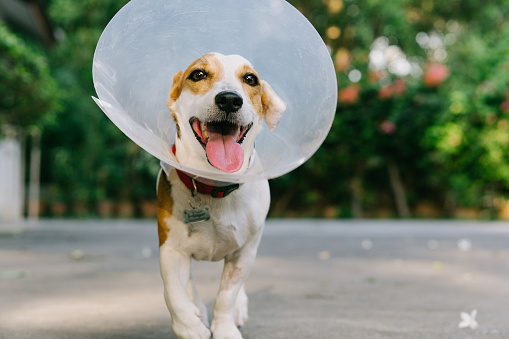
SPAY/NEUTER/CASTRATE/FIX OR STERILISE –
TAKE CARE AFTER SURGERY
Taking your pet to be sterilised is a preventative surgery that has multiple benefits. Still, it can be unsettling for both pet and person.
WHAT IS STERILISATION?
To sterilise a dog or cat is to remove its ability to produce offspring. It can be done surgically or chemically. Surgical options for female dogs (spay) include ovariectomy (removal of the ovaries only) and ovariohysterectomy (removal of ovaries and uterus)—the results of which are permanent. Male dogs are castrated or neutered by the removal of testicles.
There are also several hormone-like medications available that reduce or inhibit reproduction. Used correctly, these options can be less traumatic than surgery but misuse can result in failure to prevent breeding.
WHY IS IT IMPORTANT?
The obvious advantage of sterilisation is the reduction in unwanted pets.
Additionally for intact pets, research has shown an increased cancer risk, especially in those organs that have rapidly dividing cells; the reproductive organs. Perhaps not so obvious is the fact that unsterilised pets display often unwanted behaviour related to hormonal fluctuations. It is important to remember that, unlike people, pets don’t choose to have kids or not—they will breed in the right conditions if the opportunity presents itself.
WHAT HAPPENS AT THE VET?
Before your pet’s procedure, your vet may have advised you not to offer food. One of the reasons for bringing your pet to surgery with an empty stomach is that an animal may vomit under anaesthesia and breathe in stomach contents. This can lead to aspiration pneumonia or even death. There are differing opinions on the period of time your pet should fast before coming for surgery, from anywhere between 3 to 12 hours before the procedure. Not all pets experience nausea while under anaesthetic or on sedatives, but many do so it is better to be safe than sorry.
Dogs and cats are usually given a mixture of drugs before surgery. Specific breeds, age and pre-existing medical conditions are carefully considered by your vet to ensure the safest combinations. Sedatives, anxiolytics¹, analgesics², antibiotics, and anti-inflammatories can be combined according to each practice’s protocols. They can ensure a smoother induction, a safer anaesthetic and a calmer recovery for your animal.
The actual surgery takes up less time than you may think. Depending on the type of surgery, sterilisation may only require a small incision into the skin. Vets and nurses are trained to ensure aseptic techniques are used for all surgical procedures. This means that everything in the operating field is as free from infectious agents as possible. Some vets will inject your pet with antibiotics to provide further cover against infection.
Most veterinary hospitals or clinics keep pets for a few hours after surgery to monitor recovery. This way, they can deal with any complications immediately. Regaining consciousness, balance and normal clinical values (heart rate, breathing, blood pressure and temperature) after surgery is very important before your pet can be discharged.
HOME TIME
On collection of your pet, it is imperative that you receive clear written or verbal instructions from the vet or nurse regarding the recovery and rehabilitation journey ahead.
Drugs used to induce and maintain anaesthesia must be broken down by the liver and so it is normal to see vomiting, diarrhoea, inappetence, and lethargy up to a day after surgery. A small meal should be offered at home and water should be available at all times. Don’t be alarmed if your pet doesn’t have an appetite or if they just want to sleep it off in a dark, quiet spot. Anaesthetic agents also suppress the central nervous system (including the brain). Because of this, your pet’s behaviour may seem strange for up to 24 hours after surgery.
If you have multiple pets, keep an eye on interaction between them or keep them apart for the first day. Strange behaviour may be misconstrued by other pets, which could result in an attack.
The most important aspect of recovery at this point is wound healing. Your pet may have a course of pain killers and antibiotics to assist with the process. Once stitched, tissue begins to heal almost immediately. However, it takes at least 10 days for scar tissue (not as strong as skin) to withstand normal tension without the aid of stitches. At this stage, it is very important to prevent your pet licking or biting their wound. Apart from causing bacterial infection, physical damage to the tissue may result in the need to re-stitch the site—not something you or your pet want! Undergoing another anaesthetic is both costly to you and dangerous for your pet. Therefore, for the first 10 days, Elizabethan collars or soft alternatives must be used whenever you don’t have eyes on your fur kid.
TOP TIP: Use a gentle cleansing solution (appropriate for animals) or ½ teaspoon of salt in 250 MLS warm water to wipe the wound daily if there is discharge or dirt. If it looks clean, allow it to heal without interference.
Rough play, running and jumping also place severe strain on a stitched wound. So, for at least 10 days after surgery, leash walks are the name of the game to ensure the stitches hold the wound securely.
Different types of suture materials can be used depending on your vet’s protocol. Absorbable stitches do not need to be removed as the body can break them down. They are a popular choice for very nervous dogs who don’t like coming to the vet. Non-absorbable sutures can be less reactive in sensitive skin, but must be removed by the vet or nurse. Whichever type is used, the wound must be supported by the stitches for at least 10–14 days.
WOUND HEALING
TOP TIP: Inflammation is the body’s natural response to an irritant, characterised by redness, swelling and pain. To keep track of your pet’s healing, you might want to take a picture of the surgical site on day 1 after surgery and each day after that.
On the first day, the wound will show all the signs mentioned above, but the signs will reduce daily until the wound has become a small scar. Infection or physical damage will also postpone healing, which is another reason why keeping the wound clean is so important. However, as long as you do this and your pet is fed a balanced food containing the correct amount of protein, carbohydrates and fat, the body will have all the tools it needs to heal beautifully. Supplements and dietary changes are unnecessary in the case of a simple surgical wound. Your pet should be back to normal in no time.
Your vet or nurse may book a check-up about 2 days after surgery too. At this appointment, it is easy to see whether healing is progressing or if there is a problem.
If you are concerned about your pet during the recovery process, you should contact your vet immediately.
¹Anxiolytics: drugs used to reduce anxiety.
²Analgesics: drugs used to reduce pain.
Copyright Liz Roodt 2022
